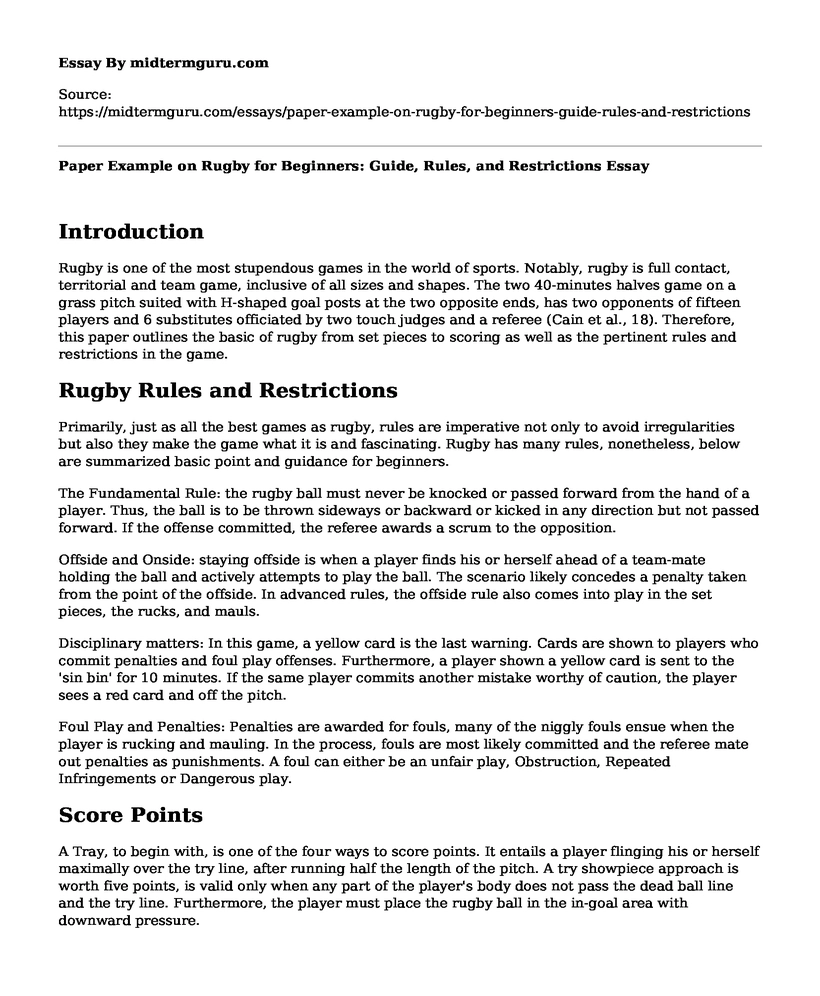Introduction
Rugby is one of the most stupendous games in the world of sports. Notably, rugby is full contact, territorial and team game, inclusive of all sizes and shapes. The two 40-minutes halves game on a grass pitch suited with H-shaped goal posts at the two opposite ends, has two opponents of fifteen players and 6 substitutes officiated by two touch judges and a referee (Cain et al., 18). Therefore, this paper outlines the basic of rugby from set pieces to scoring as well as the pertinent rules and restrictions in the game.
Rugby Rules and Restrictions
Primarily, just as all the best games as rugby, rules are imperative not only to avoid irregularities but also they make the game what it is and fascinating. Rugby has many rules, nonetheless, below are summarized basic point and guidance for beginners.
The Fundamental Rule: the rugby ball must never be knocked or passed forward from the hand of a player. Thus, the ball is to be thrown sideways or backward or kicked in any direction but not passed forward. If the offense committed, the referee awards a scrum to the opposition.
Offside and Onside: staying offside is when a player finds his or herself ahead of a team-mate holding the ball and actively attempts to play the ball. The scenario likely concedes a penalty taken from the point of the offside. In advanced rules, the offside rule also comes into play in the set pieces, the rucks, and mauls.
Disciplinary matters: In this game, a yellow card is the last warning. Cards are shown to players who commit penalties and foul play offenses. Furthermore, a player shown a yellow card is sent to the 'sin bin' for 10 minutes. If the same player commits another mistake worthy of caution, the player sees a red card and off the pitch.
Foul Play and Penalties: Penalties are awarded for fouls, many of the niggly fouls ensue when the player is rucking and mauling. In the process, fouls are most likely committed and the referee mate out penalties as punishments. A foul can either be an unfair play, Obstruction, Repeated Infringements or Dangerous play.
Score Points
A Tray, to begin with, is one of the four ways to score points. It entails a player flinging his or herself maximally over the try line, after running half the length of the pitch. A try showpiece approach is worth five points, is valid only when any part of the player's body does not pass the dead ball line and the try line. Furthermore, the player must place the rugby ball in the in-goal area with downward pressure.
A penalty kick: is a direct kick at the goal that is awarded because of infringement. With the ball placed at the point of the offense, a successful kick over the crossbar and between the posts considered a goal and awarded 3 Points.
Conversion: this a is an extra kick awarded to a team after a successful Try score to convert the score into another two more extra points. The conversion is taken from any point provided the point is in line with where the try score was executed.
A Drop Goal: drop goal earn the team three more points. It is scored by a kick from any point of the pitch provided the ball touches the ground within the in-goal area.
Set Pieces
Notably, this the most crucial part of the game as it defines the referee's verdicts in the game. The referee will restart the game in case of infringement by either a scrum or lineout.
The lineout: primary is a jumping contest to win the ball's possession. Past the five-meter line, the two teams line up, a hooker throws the ball toward his teammate supported to rise and catch the ball, and if he catches the ball, then the play continues. On the other hand, the scrum is a result of stop by the referee because of a forward pass, accidental offside or a knock. Scrum involve a masculine struggle for the ball, down in the middle of the two teams the ball is placed, and more dominant team retrieve it back to their hooker the play resumes (Cain et al., 80).
Tackle, Rucking, and Mauling
Only the player possessing the ball can be attacked. A lousy tackle causes Ruck; the teammates release the ball immediately by binding together over the ball and push the opponents back using their feet to keep the ball in play. The Maul is similar to ruck only with the difference that I this case the player with the ball remains on his feet In conclusion, from the above outline, one can realize even though rugby is a game of rules and restrictions it is not only comfortable but also splendorous and enjoyable.
Work Cited
Cain, Nick, and Greg Growden. Rugby Union for Dummies. Chichester [ 3rd ed] [U.K.: Wiley, 2011. Internet resource. P. 384, access no. 9781119970415.
Cite this page
Paper Example on Rugby for Beginners: Guide, Rules, and Restrictions. (2022, Sep 25). Retrieved from https://midtermguru.com/essays/paper-example-on-rugby-for-beginners-guide-rules-and-restrictions
If you are the original author of this essay and no longer wish to have it published on the midtermguru.com website, please click below to request its removal:
- Essay on the History of Baseball
- A Senior Coach Experience: Training College Marathon Athlete
- Sports Role in the Global Culture - Essay Sample
- Paper Example on Training the Aerobic Capacity of Distance Runners
- US Women's Soccer: Unfair Remuneration and Discrimination - Essay Sample
- Owning/Operating A Gym - Essay Sample
- NFL Playoffs - Exciting Elimination Tournament for Determining Champion - Essay Sample







